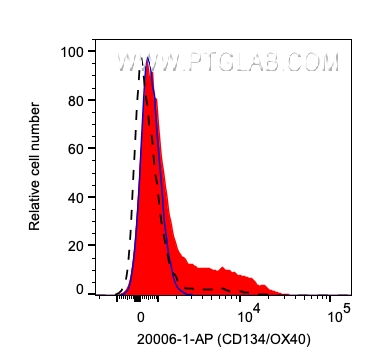验证数据展示
经过测试的应用
| Positive WB detected in | MJ cells |
| Positive FC detected in | PHA treated human PBMCs |
推荐稀释比
| 应用 | 推荐稀释比 |
|---|---|
| Western Blot (WB) | WB : 1:500-1:2000 |
| Flow Cytometry (FC) | FC : 0.20 ug per 10^6 cells in a 100 µl suspension |
| It is recommended that this reagent should be titrated in each testing system to obtain optimal results. | |
| Sample-dependent, Check data in validation data gallery. | |
发表文章中的应用
| WB | See 2 publications below |
产品信息
20006-1-AP targets CD134/OX40 in WB, FC, ELISA applications and shows reactivity with human samples.
| 经测试应用 | WB, FC, ELISA Application Description |
| 文献引用应用 | WB |
| 经测试反应性 | human |
| 文献引用反应性 | human |
| 免疫原 |
Peptide 种属同源性预测 |
| 宿主/亚型 | Rabbit / IgG |
| 抗体类别 | Polyclonal |
| 产品类型 | Antibody |
| 全称 | tumor necrosis factor receptor superfamily, member 4 |
| 别名 | TNFRSF4, ACT35, ACT35 antigen, CD134, OX40 |
| 计算分子量 | 29 kDa |
| 观测分子量 | 50-55 kDa, 40 kDa |
| GenBank蛋白编号 | NM_003327 |
| 基因名称 | CD134 |
| Gene ID (NCBI) | 7293 |
| RRID | AB_10733472 |
| 偶联类型 | Unconjugated |
| 形式 | Liquid |
| 纯化方式 | Antigen affinity purification |
| UNIPROT ID | P43489 |
| 储存缓冲液 | PBS with 0.02% sodium azide and 50% glycerol, pH 7.3. |
| 储存条件 | Store at -20°C. Stable for one year after shipment. Aliquoting is unnecessary for -20oC storage. |
背景介绍
CD134 (OX40) is a member of the TNFR-superfamily of receptors. Predominantly expressed on activated T cells, CD134 is activated by its cognate ligand CD134L (OX40L) and functions as a T cell co-stimulatory molecule. CD134-CD134L interactions have been proposed as a potential therapeutic target for treating autoimmunity (PMID: 26215166). CD134 can interact with TRAF2, TRAF3, and TRAF5.
实验方案
| Product Specific Protocols | |
|---|---|
| FC protocol for CD134/OX40 antibody 20006-1-AP | Download protocol |
| WB protocol for CD134/OX40 antibody 20006-1-AP | Download protocol |
| Standard Protocols | |
|---|---|
| Click here to view our Standard Protocols |
发表文章
| Species | Application | Title |
|---|---|---|
Front Immunol A Novel Immune-Related Gene Signature to Identify the Tumor Microenvironment and Prognose Disease Among Patients With Oral Squamous Cell Carcinoma Patients Using ssGSEA: A Bioinformatics and Biological Validation Study | ||
Dis Markers Development of a Costimulatory Molecule Signature to Predict Prognosis, Immune Landscape, and Response to Immune Therapy for Hepatocellular Carcinoma |



